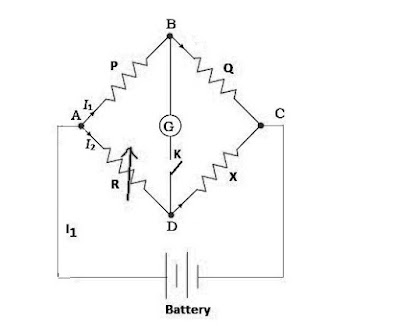This bridge was first introduced by Wheatstone for measuring the value of unknown resistance.
Wheatstone bridge circuit consists of four resistors, two with known resistances P & Q and one known variable resistance R, and one unknown resistor X whose value is to be calculated.
All four resistors are connected in a manner to form a diamond-like shape circuit ABCDA as shown in the Wheatstone Bridge circuit diagram.
Across one pair of opposite junctions A&C battery is connected and across other junctions B & D a galvanometer is connected and key K is connected in series with the galvanometer as shown in the diagram.
This circuit is called a bridge because the galvanometer bridges the opposite junctions B & D.
Working Principle of Wheatstone Bridge
The working principle of this bridge is based on the null deflection. When the bridge is balanced, the ratio of their resistances is equal and no current flows through the galvanometer.
Consider I1 and I2 are the currents that pass through P & R respectively.

When the bridge is balanced no current passes through the galvanometer. Current in resistor Q & X are I1 and I2 because B & D are at equipotential and the galvanometer reads zero voltage.
Hence voltage drop across branch A to B and A to D must be equal also voltage drop across branches B to C and D to C must be equal.
I1P= I2R and I1Q=I2X


This is the formula of Wheatstone Bridge to calculate the value of the unknown resistor.
Hence, when the bridge is balanced the product of the resistances of opposite branches of the bridge are equal.
Wheatstone Bridge Application
- This bridge is used for the precise measurement of low resistance.
- Wheatstone bridge along with an O AMP (operational amplifier) is used to measure temperature, light, and strain.
- capacitance, inductance, and impedance can also be calculated using this bridge.
- light detector circuit can be constructed using the Wheatstone bridge.
Limitations
- For low resistance measurement, the resistance of the wires and contacts becomes significant and introduces an error in measurement.
- This bridge can be used to measure resistance ranging from a few ohms to megaohms and is not suitable to measure very large resistance because the galvanometer becomes insensitive in such cases.
- The other drawback is the change in the resistance due to the heating effect of the resistor because of the heavy current flowing through it leads to error in measurement.